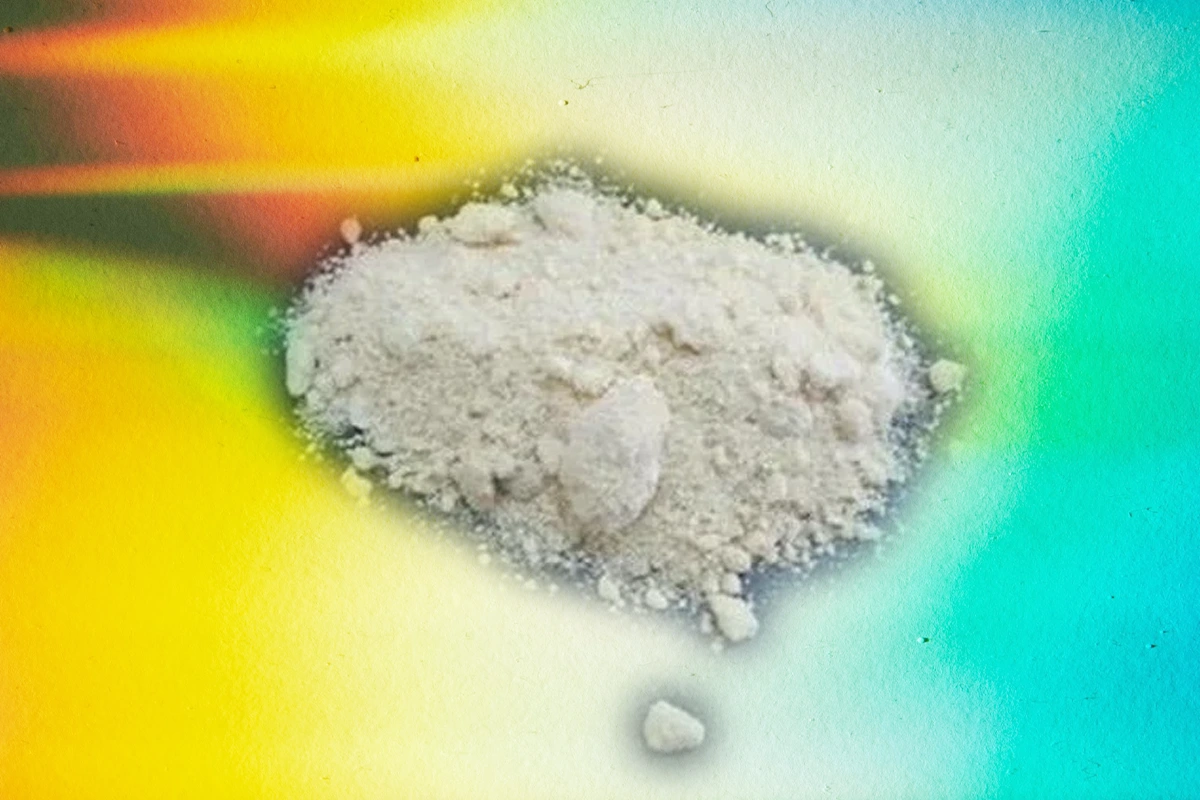If you live in a major North American city, you may have noticed a sudden influx of psychedelics-laced gummies, chocolates, and various other products in your local smoke shops or corner stores. Many of these are likely labeled as containing psychoactive mushrooms, such as Amanita muscaria. But looks can be deceiving.
In many cases, these products are not made with organic compounds derived from mushrooms. Instead, they’re manufactured with a hazily understood drug: 4-acetoxy-N,N-dimethyltryptamine, better known as 4-AcO-DMT, psilacetin, or “synthetic mushrooms.” For decades, 4-AcO has been swirling around on the fringes of the psychedelic underworld, a bit player in a drama dominated by bigger actors like LSD, psilocybin, DMT, and MDMA. But now it’s beginning to have its moment in the spotlight, thanks in large part to a new wave of entrepreneurs looking to make a quick profit.
Like so much psychedelic lore, the story of 4-AcO begins in Switzerland, in the lab of Albert Hofmann—the same chemist who, in the 1940s, discovered the molecule that we now call LSD. Along with his lab partner Franz Troxler, Hofmann first synthesized 4-AcO in 1963 as a chemical analogue to psilocybin, the active ingredient in magic mushrooms which he’d isolated from the Psilocybe mexicana mushroom five years earlier. Hofmann never seemed to regard 4-AcO with any special interest; it was created purely as part of a broader study into synthetic psilocybin analogues, put on a shelf, and apparently forgotten. In this respect, the genesis of 4-AcO was a bit like that of LSD: created in a lab and then long ignored, only to be embraced years later by a psychedelic subculture. And like LSD, 4-AcO has been a bit of a problem child.
READ: LSD, Demons, Milk, and “Medicine for the Soul”
More than three decades after it was first synthesized, another celebrated psychedelic chemist would bring 4-AcO into the light. In 1999, Heffter Research Institute founder Dr. David Nichols published a scientific paper in which he argued that 4-AcO “may offer an economical alternative for clinicians wishing to study the psychopharmacology of psilocin.” (Both psilocybin and 4-AcO are converted by the body to the psychedelic tryptamine psilocin after being ingested.) Whereas organic, psilocybin-containing mushrooms are both relatively expensive and time-consuming to cultivate—especially if contamination becomes an issue—4-AcO could be manufactured cheaply, quickly, and in copious amounts. And given its chemical kinship with psilocybin, the two compounds would also possess similar psychoactive qualities, at least in theory.
Here, Nichols proposed, was a compound that could help to fuel psychedelic research, then regaining momentum after a decades-long hiatus following the 1970 passing of the Controlled Substances Act, which federally outlawed the classic psychedelics.
Being a chemist, Nichols was in no position to study 4-AcO’s phenomenology by administering it to human subjects. In fact, the compound’s psychoactivity still remains more or less shrouded in mystery, at least from a scientific standpoint: to date, no clinical trials investigating its subjective effects on humans have been conducted. One 2019 study investigating the psychoactive effects of several different tryptamines found that 4-AcO caused mice to rapidly rotate their heads from side-to-side—a movement known as a head-twitch response (HTR), which indicates a psychedelic effect.
How to Grow Shrooms Bundle
Take Both of Our Courses and Save $90!
4-AcO has, for the most part, eluded law enforcement. The compound has sporadically popped up on the legal radar over the years, but overall it appears to have kept a low profile. Europol, the European Union’s law enforcement body, officially listed 4-AcO in a 2009 report on the “risk-assessment and control of new psychoactive substances”—basically a declaration that the agency had officially begun to track the drug in Europe. Similarly, the United Nations Office on Drugs and Crime (UNODC) officially recognized the drug in a 2013 report as a New Psychoactive Substance (NPS), which the Office defines as “substances of abuse, either in a pure form or a preparation, that are not controlled by the 1961 Single Convention on Narcotic Drugs or the 1971 Convention on Psychotropic Substances, but which may pose a public health threat.”
Here in the US, 4-AcO exists in something of a legal grey area. In 1986, Congress passed the Controlled Substance Analogue Enforcement Act, an amendment to the CSA intended to counteract the then-rising trend of “designer drugs,” or synthetic analogues of controlled substances. Under the amendment, synthetic compounds that are “substantially similar” to Schedule 1 or 2 drugs, both in terms of their chemical structure and their psychoactive properties, and which are intended for human consumption, are automatically relegated to Schedule 1, the US Drug Enforcement Administration’s (DEA) strictest category of control.
Therefore, 4-AcO should technically be relegated to Schedule 1 by default and strictly illegal for everyone, except researchers with a license issued by the DEA. (The compound is not officially listed in the DEA’s official List of Controlled Substances and Regulated Chemicals, however.)
It’s remarkable how blatantly visible and easily accessible the drug has become. While most Schedule 1 drugs—like LSD, MDMA, and heroin—are pedaled almost exclusively through underground channels, 4-AcO is increasingly sold out in the open, but it is usually not labeled as such. Again, some companies will use 4-AcO in psychedelics-laced products while labeling them as containing psychoactive mushrooms or a “mushroom blend.” In this respect, it’s a bit like the legal loophole occupied by THC isomers like delta-8: It’s not quite the real thing, but it’s close enough that most users won’t notice a difference. Also, law enforcement is unlikely to go through the legal rigamarole required to prosecute for a drug that, for all real intents and purposes, is suspended in legal limbo.
This bizarre situation has been enabled in part by the linguistic murkiness of the Federal Analogue Act itself. “In its attempt to draft a law broad enough to prospectively criminalize all possible future narcotics, Congress created a statute so vague as to prevent any advance knowledge of the substances criminalized while also leaving every substance in a superposition of legal states as both legal and illegal,” attorney Andrew Fels wrote in a 2021 paper, which argued that Congress should nullify the Act.
For one thing, the statute does not explicitly state what it means by “substantially similar.” According to Andrea Golan, an attorney who specializes in the cannabis and psychedelics industries, there are three different tests used in different court circuits across the country. “There’s not a definitive answer to the substantial similarity question,” she says. Based on her own analysis, Golan says that 4-AcO probably does meet the three criteria for being a Schedule 1 drug. “What it really reflects is how little this issue has come before the courts,” she says. “There’s just not a lot of case law on [the] Analogue Act, period.”
Following the publication of Nichols’ 1999 paper, a new generation of psychonauts was keen to explore the psychological terrain that 4-AcO might unlock. Online forums like Erowid and Reddit contain huge numbers of accounts from people who have experimented with 4-AcO. Some have written that in smaller doses, 4-AcO—which can be ingested orally or nasally, usually in the form of an off-white powder—feels similar to psilocybin, while larger doses can catapult the user into interstellar realms reminiscent of a DMT trip. It’s also become a popular choice among microdosers: A 2019 paper published in Harm Reduction Journal, which analyzed YouTube videos of people recounting their experiences microdosing different psychedelics, found that some people preferred 4-AcO, “claiming it provided both the cognitive clarity of LSD and the emotional awareness and groundedness of psilocybin.”
Since it’s a prodrug of psilocin, 4-AcO doesn’t seem to pose any serious health risks. “Psilocin’s a fairly innocuous molecule, although some people should never take a psychedelic,” says Nichols. “But I wouldn’t see [4-AcO] being any more dangerous than psilocybin or maybe even eating mushrooms.”
Earlier this month, the FDA issued a warning against selling or ingesting Diamond Shruumz chocolate—which, while labeled as a “microdosing” product, has a list of ingredients that’s limited to trendy (and legal) “functional” mushrooms like lion’s mane and chaga. According to the agency, Diamond Shruumz products have caused “a variety of severe symptoms including seizures, central nervous system depression (loss of consciousness, confusion, sleepiness), agitation, abnormal heart rates, hyper/hypotension, nausea, and vomiting.” A report from The New York Times pointed a finger at 4-AcO as a potential culprit, noting (accurately) that the compound’s health effects remain largely unstudied.
But it isn’t just the compound itself that poses a potential danger. As with any synthetic drug, one should always consider the other chemicals that are used in the production process. This is where things can get potentially dangerous, says Masha Ty, head of corporate growth at ACS Laboratory, an analytical chemistry lab focused on cannabis and psychedelics. According to Ty, opportunistic chemists seeking to make a profit off of 4-AcO will sometimes use other, poorly understood chemicals in the synthesizing process. “When chemists are creating new products, it’s moving at such a fast pace that they’re using solvents and acids that are not even on the radar of legislators or anybody that’s creating these draft rules,” she says. “We don’t even know what they’re using.”
That lack of clarity sometimes extends to the brands that end up selling 4-AcO-laced products, Ty adds. Occasionally, such brands will submit products to ACS for testing, and the resulting lab reports will list “ketamine, amphetamine, like, crazy stuff,” she says. The part that scares her the most is that these brands are often selling their wares out in the open, without any kind of regulation or enforcement around age restrictions. “These products are in gas stations,” she says. 4-AcO can also be purchased in bulk online as a “research chemical.”
As part of a recent investigative story, DoubleBlind partnered with Hyphae Labs in Oakland, CA, to analyze a group of products that were labeled as containing various kinds of psychoactive mushrooms. The test detected 4-AcO in the majority of the products—though it was not listed on any of their labels.
This, of course, raises the critical issue of informed consent. Even if a drug produces an effect that’s (to borrow from the DEA’s language) “substantially similar” to a different drug that someone thinks they’re taking, the fact remains that they’re two separate entities, with their own origins, their own chemistry, their own side effects. Loading a chocolate bar with a poorly understood white powder and then slapping a label emblazoned with mushrooms on it, leading consumers to believe that it contains natural ingredients, is just about as antithetical to “wellness” as you can possibly get.

DoubleBlind is a trusted resource for news, evidence-based education, and reporting on psychedelics. We work with leading medical professionals, scientific researchers, journalists, mycologists, indigenous stewards, and cultural pioneers. Read about our editorial policy and fact-checking process here.

DoubleBlind Magazine does not encourage or condone any illegal activities, including but not limited to the use of illegal substances. We do not provide mental health, clinical, or medical services. We are not a substitute for medical, psychological, or psychiatric diagnosis, treatment, or advice. If you are in a crisis or if you or any other person may be in danger or experiencing a mental health emergency, immediately call 911 or your local emergency resources. If you are considering suicide, please call 988 to connect with the National Suicide Prevention Lifeline.



